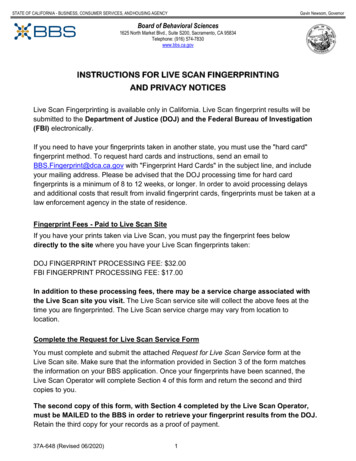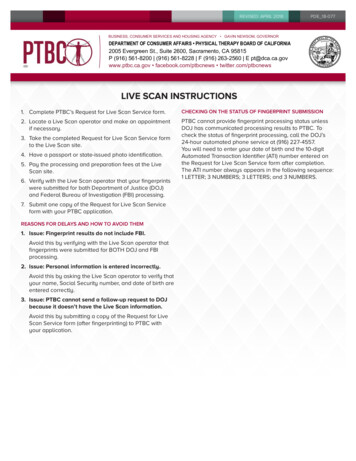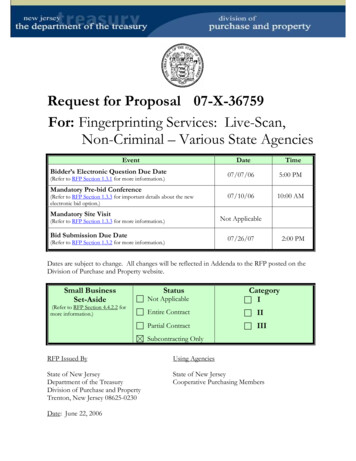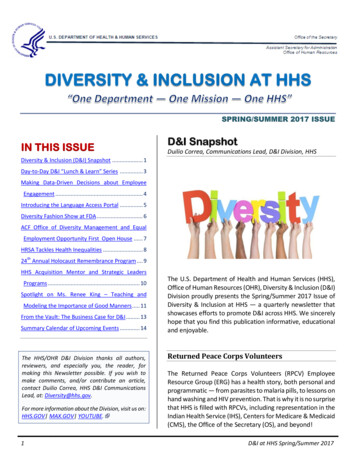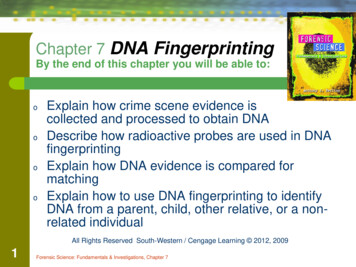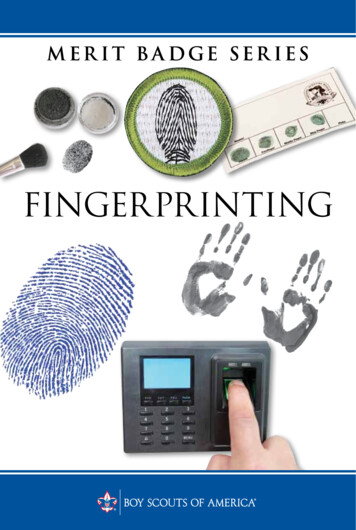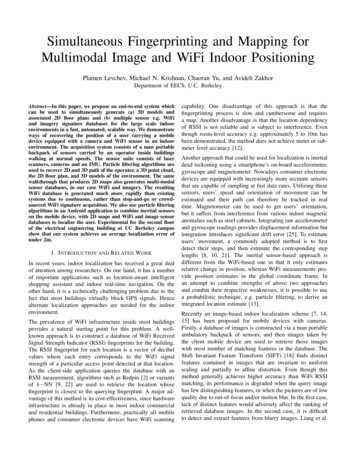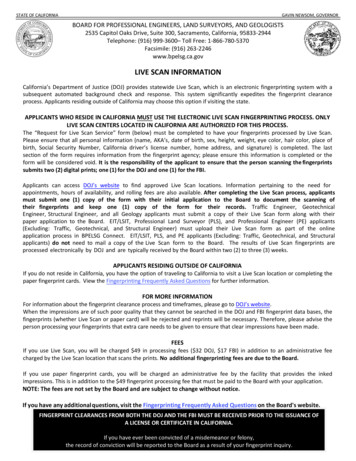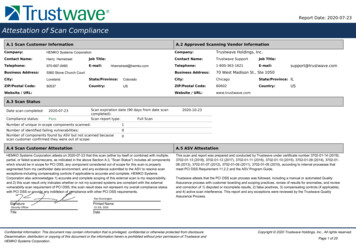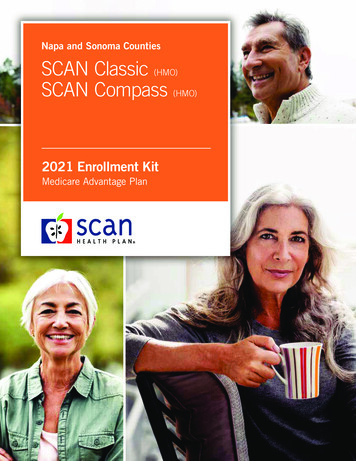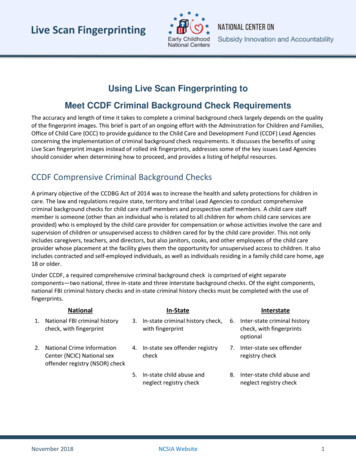
Transcription
Live Scan FingerprintingUsing Live Scan Fingerprinting toMeet CCDF Criminal Background Check RequirementsThe accuracy and length of time it takes to complete a criminal background check largely depends on the qualityof the fingerprint images. This brief is part of an ongoing effort with the Adminstration for Children and Families,Office of Child Care (OCC) to provide guidance to the Child Care and Development Fund (CCDF) Lead Agenciesconcerning the implementation of criminal background check requirements. It discusses the benefits of usingLive Scan fingerprint images instead of rolled ink fingerprints, addresses some of the key issues Lead Agenciesshould consider when determining how to proceed, and provides a listing of helpful resources.CCDF Comprensive Criminal Background ChecksA primary objective of the CCDBG Act of 2014 was to increase the health and safety protections for children incare. The law and regulations require state, territory and tribal Lead Agencies to conduct comprehensivecriminal background checks for child care staff members and prospective staff members. A child care staffmember is someone (other than an individual who is related to all children for whom child care services areprovided) who is employed by the child care provider for compensation or whose activities involve the care andsupervision of children or unsupervised access to children cared for by the child care provider. This not onlyincludes caregivers, teachers, and directors, but also janitors, cooks, and other employees of the child careprovider whose placement at the facility gives them the opportunity for unsupervised access to children. It alsoincludes contracted and self-employed individuals, as well as individuals residing in a family child care home, age18 or older.Under CCDF, a required comprehensive criminal background check is comprised of eight separatecomponents—two national, three in-state and three interstate background checks. Of the eight components,national FBI criminal history checks and in-state criminal history checks must be completed with the use offingerprints.NationalIn-StateInterstate1. National FBI criminal historycheck, with fingerprint3. In-state criminal history check,with fingerprint6. Inter-state criminal historycheck, with fingerprintsoptional2. National Crime InformationCenter (NCIC) National sexoffender registry (NSOR) check4. In-state sex offender registrycheck7. Inter-state sex offenderregistry check5. In-state child abuse andneglect registry check8. Inter-state child abuse andneglect registry checkNovember 2018NCSIA Website1
Live Scan FingerprintingWhy is it Important to Capture Quality Fingerprints?If the quality of the fingerprint images submited for either a national or in-state criminal history recordbackground check is too low, the background check cannot be completed.1 Ensuring that fingerprint images areof high quality helps to: Mitigate potential risks: Low quality fingerprints may fail to correctly identify a criminal record. In such ascenario, vulnerable populations may be put at an unnecessary risk. Get results quicker and with less administrative burden: Fingerprints need to be retaken if a backgroundcheck is rejected because the fingerprint quality is too low. This increases the administrative burden,possibly the costs, and may result in longer wait times before the individual can work without supervision. Reduce inconvenience related to Rap Back Service: For states that subscribe to Rap Back services, enrollingan applicant in the FBI Next Generation Identification (NGI) Noncriminal Justice Rap Back Service requiresthe applicant’s fingerprints to be retained in the FBI’s NGI system. The Rap Back Service notifies authorizedentities when a person who has fingerprints within the FBI's Next Generation Identification system isarrested or has criminal activity against those fingerprints. States can request the FBI to conduct a nameonly criminal background check if the fingerprints submitted are rejected twice due to low quality. However,there will be no fingerprints on file to establish the Rap Back subscription.The Benefits of Using Live Scan Fingerprinting for Completing CCDF CriminalBackground ChecksFingerprinting is a critical part of the CCDF-required comprehensive background checkprocess. Live Scan is an inkless, electronic means of capturing fingerprints in adigitized format and transmitting them to the state criminal justice agencies and theFBI. Prior to the development of Live Scan biometric technology, fingerprints weretaken by applying ink to each finger, then rolling each finger on a fingerprint card. Thequality of rolled ink fingerprints varies widely. It is not uncommon for rejection ratesto average near 30 percent, and rejection rates of up to 60 percent have beenreported. The process needs to be repeated if the FBI rejects the fingerprints due tolow quality. This results in increased administrative burden and costs, and delayslasting weeks or months.Live Scan fingerprinting avoids many of the problems associated with rolled ink fingerprints, such as smudgingand smearing that lead to fingerprints that are not readible. The scanning software contains integrated qualitycontrols that help to ensure the image quality is acceptible prior to submission. The rejection rate for Live Scanfingerprints is generally less than 1 percent. Imaged fingerprints can be transmitted to criminal justice agencieswithin seconds while rolled ink fingerprint cards are submitted by mail. Another major benefit is that that theFBI returns the background check results to the state within 24 to 72 hours. This is an important benefit to childcare providers who depend on Lead Agencies to establish efficient processes that will allow new employees towork without supervision as soon as l-fingerprint-image-quality-flyer.pdf/viewNovember 2018NCSIA Website2
Live Scan FingerprintingCertified Live Scan DevicesThere are many types of Live Scan devices (e.g., single or multiple fingers and mobile) that have differentcapabilities and image quality. The FBI established Integrated Automated Fingerprint IdentificationSystem (IAFIS) image quality standards that must be met for scanning equipment to be certified. Thesestandards ensure consistency of quality and usability, and that the system works with other information systems(interoperability). There are two standards currently in use—Personal Identify Verification (PIV) single finger andIAFIS IQS Appendix F. PIV is a lower standard designed to support one-to-one fingerprint verification for federalemployees and contractors.Appendix F has stringent image quality standards. An Appendix F certification assures that the Live Scan systemmeets or exceeds the minimum FBI interoperability standards and that it will work with the NGI system. Thesestandards ensure that images are high quality and support completion of all aspects of the identificationprocess. In most cases, state criminal justice agencies are responsible for submitting background checks to theFBI for licensing and employment purposes. Lead Agencies considering the purchase of Live Scan devices shouldconsult with their criminal justice agencies for additional information.Live Scan CostsLive Scan fingerprinting does not affect the fee the FBI charges for completing a criminal history check. The costis in the the Live Scan system and equipment needed to establish a secure network connection to the statecriminal justice agency/repository. A 2013 market study conducted for the U.S. Department of HomelandSecurity found that the cost of certified Live Scan devices generally ranged between 2,000 and 48,000. TheFBI’s website has a searchable Certified Product List of live scan systems that comply with the IAFIS IQSAppendix F standards (refer to FBI Certified Products List).It is important to note that the Consolidated Appropriations Act of 2018, which became law on March 23, 2018,increased the Discretionary amount of CCDF funding by 2.37 billion for fiscal year 2018, in part to support thefull implementation of the CCDBG Act of 2014. This increased funding level was maintained in FY 2019.Theincreased funding presents an opportunity for infrastructure investments needed to comply with the criminalbackground check requirements. This could include fingerprinting equipment and other IT investments that donot count against the administrative cost cap under 45 CFR 98.54(b) of the CCDF regulations.2 Lead Agencieshave until September 30, 2019 to obligate funds and September 30, 2020, to liquidate the funds.Considerations for Purchasing Live Scan DevicesA first step is to determine how existing Live Scan devices are used and if opportunities exist to leverage thesedevices before deciding to purchase additional equipment. Most states own and operate certified Live Scandevices, including criminal justice and education agencies. However, the existing infrastructure may not provideadequate coverage statewide or have the capacity to process the additional volume of criminal backgroundcheck requests. There are a large number of private live scan vendors with whom Lead Agencies may consdercontracting.2Child Care and Development Block Grant, Child Care and Development Fund (CCDF), Consolidated Appropriations Act of 2018: CCDFACF-IM-2018-03.November 2018NCSIA Website3
Live Scan FingerprintingLead Agencies should conduct a thorough evaluation to determine the most practical, efficient, and least costlyoption for implementing Live Scan fingerprinting. The National Crime Prevention and Privacy Compact Council,in collaboration with the FBI, developed a Civil Fingerprint Image Quality Strategy Guide. The Guide is a resourcefor assisting states in making programmatic decisions to improve civil fingerprint image quality. It containsinformation that is useful in helping states to assess their options. A web link to the Guide is contained in theOther Resources listing below.State ExamplesThe Alabama Department of Human Resources (DHR) contracted with a vendor to complete the national and instate criminal registry checks. Child care staff register online through the contract vendor's website. A link to thecontract vendors' website is on the Lead Agency website. The website includes registration information,frequently asked questions, location of Live Scan fingerprint sites, and other information to help child care staffunderstand the process. The staff members can visit any fingerprint location in Alabama and submit fingerprintimages electronically using a Live Scan device.The Kentucky Cabinet for Health and Family Services (CHFS/Cabinet), Department for Community Based Services(DCBS) requires child care staff members (current employees as well as new hires) to enroll in the NationalBackground Check Program (NBCP) Kentucky Applicant Registry and Employment Screening background checkprogram (KARES) Web Portal. The KARES Web portal, developed with grant support from the U.S. Department ofHealth and Human Services’ Children’s Bureau and the Centers for Medicare and Medicaid Services (CMS), isaccessed through a secured gateway called the Kentucky Online Gateway (KOG). Each user needs to create aKOG user account to access the KARES system. Once the applicant’s or staff member’s information is entered,the state’s sex offender and child abuse and neglect registries check for any information on the applicant. Oncethe applicant is cleared, the system generates paperwork for the applicant to take to one of the 80 Live Scanlocations across the state.The Ohio Attorney General’s Bureau of Criminal Investigation (BCI) processes 1 million background checksannually for schools, hospitals, daycare centers, and other employers. Approximately 50 contracted WebCheckagencies transmit Live Scan fingerprints background check request data electronically to BCI. BCI sends theresults directly to the Ohio Department of Job and Family Services (ODJFS). Child care staff members also submita request to ODJFS to have the remaining background checks completed.The North Carolina Department of Health and Human Services (DHHS), Division of Child Development and EarlyEducation (DCDEE) requires all licensed and regulated child care providers and household members over the ageof 15 years old complete criminal background checks. Child care employees and prospective employees mustobtain Live Scan fingerprints. DHHS implemented an electronic Criminal Background Check Portal for individualsto apply for their criminal background check. The portal alerts applicants to get their fingerprints completed.The Utah Department of Health, Child Care Licensing (CCL) allows individuals to submit fingerprints to more thansixty-five Live Scan fingerprint scanners in the state. CCL placed a Live Scan machine at five of the six CCR&Ragencies in the state where individuals involved with child care can have their fingerprints scanned electronicallyat no cost. Utah uses the Rap Back system which allows CCL to receive daily reports from the FBI on allindividuals in the system about any criminal charges. Fingerprints are also used for an in-state criminal registrycheck through the UT Department of Public Safety.November 2018NCSIA Website4
Live Scan FingerprintingOther ResourcesLead Agencies may be interested in the following resources to consider the use of Live Scan fingerprinting inmeeting the CCDF comprehensive criminal background check requirements.:National Crime Prevention and Privacy Compact Council. Civil Fingerprint Image Quality Strategy eral Bureau of Investigation, Civil Fingerprint Image Quality Flyer: nt-image-quality-flyer.pdf/viewFBI Biometric Specifications, Certified Products List: https://www.fbibiospecs.cjis.gov/CertificationsFBI Next Generation Identification (NGI), Rap Back Service: k-service.pdf/viewDepartment of Homeland Security, Live Scan Fingerprint Systems Market Survey Report cations/LSFP-Sys-MSR 0913-508 0.pdfList of FBI-Approved Channelers for Departmental Order r 2018NCSIA Website5
If the quality of the fingerprint images submited for either a national or in-state criminal history record background check is too low, the background check cannot be completed.1 Ensuring that fingerprint images are of high quality helps to: Mitigate potential risks: Low quality fingerprints may fail to correctly identify a criminal record. In .
